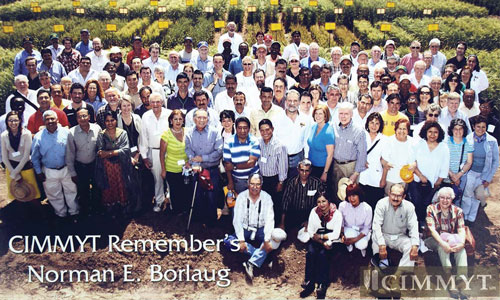First international wheat blast meeting held in Brazil
Wheat blast or ‘brusone’ is a new wheat disease caused by M. oryzae (Pyricularia oryzae). It is responsible for 5-100% of wheat yield loss in regions of South America, and has the potential to spread. To address this and other issues, a workshop titled “Wheat blast: A potential threat to global wheat production” was held in Passo Fundo, Brazil, during 03-05 May 2010, followed by a field visit to the Brasilia region. It was organized by Embrapa Wheat, Embrapa Cerrados, and CIMMYT, and attended by representatives from 11 countries.
Wheat blast was identified for the first time in 1985 in the State of Parana in southern Brazil, from where it quickly spread to neighboring countries. Four years later, it caused serious damage (40-100%) in the wheat fields of Paraguay. In the lowlands of Bolivia, it was responsible for a loss of 90,000 hectares of wheat between 1997 and 2000. In 2007, the disease was seen in summer-sown experimental wheat trials in Chaco, Argentina, and although researchers in Uruguay have not observed the disease in wheat, they have found the fungus on barley. A 2009 outbreak cut Brazilian wheat production by up to 30%.
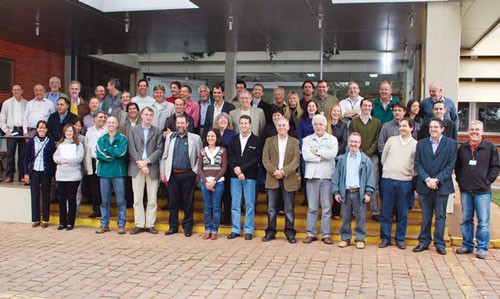
Of great concern is that chemical control of wheat blast may not be working. “There are places where farmers are using four fungicide applications with no results, which suggests the current chemicals are not effective against the fungus, or are not properly applied,” says Etienne Duveiller, wheat pathologist and associate director of CIMMYT’s Global Wheat Program. “To date, there is a lack of cultivars resistant to wheat blast, and only limited tolerance can be found.”
Climate change is adding to the problem. “A more hot and humid climate favors fungal diseases such as wheat blast, which needs high temperatures of about 24- 28°C and long periods of rain to occur,” explains researcher Gisele Torres of Embrapa Wheat. CIMMYT’s Duviller echoes these concerns: “Changes in rainfall may create environmental conditions favorable to wheat blast in other parts of the world such as South Asia or Africa. This was the main reason for inviting researchers from different wheat-producing countries in several continents to discuss wheat blast in Brazil.”
The most important diseases that affect wheat production worldwide are leaf rust (5 million ha), tan spot (4.5 million ha), and fusarium (4 million ha). “So far, new diseases like wheat blast in South America has been limited to a few countries,” says Man Mohan Kohli, ex-CIMMYT researcher once posted in South America. “Similarly the distribution of the stem rust Ug99 in Africa has been limited, but has been the object of studies by several research institutes around the world.” Efforts to improve wheat resistance to Ug99 and to reduce the risk of its spread to other countries show how international collaborative research and investment facilitates scientific response to new virulent pathotypes, or races of pathogens, that could become potentially devastating.
Researchers from the following institutions participated in the workshop, which was supported by EMBRAPA and BMZ (Germany): Göttingen University (Germany), Kansas State University (United States), CIRAD (France), CIAT (Bolivia), INTA (Argentina), INIA (Uruguay), CIMMYT (Mexico), USDA/ARS (United States), MAG/ DIA (Paraguay), and Wageningen University (Netherlands), as well as Brazil Embrapa Cerrados, Embrapa Wheat, Labex Europa, OR, BIOTRIGO, COODETEC, FUNDACEP, UPF, UNESP, and Fapa/Agrária.
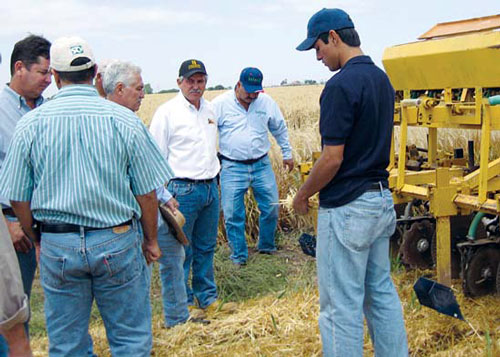 CIMMYT CA experts Jesús Mendoza and Dagoberto Flores led the event, which was the second of what will be a series of monthly CA meeting for local farmers in the Mexican Pacific zone who collaborate with CIMMYT and host CA modules in their land. The expectation is that the meetings will be a venue for farmers to exchange ideas and suggestion to improve their practices. “Conservation agriculture is good and has many advantages,” said farmer Héctor Aguilar, “but we, as farmers, must keep up-to-date on CA.”
CIMMYT CA experts Jesús Mendoza and Dagoberto Flores led the event, which was the second of what will be a series of monthly CA meeting for local farmers in the Mexican Pacific zone who collaborate with CIMMYT and host CA modules in their land. The expectation is that the meetings will be a venue for farmers to exchange ideas and suggestion to improve their practices. “Conservation agriculture is good and has many advantages,” said farmer Héctor Aguilar, “but we, as farmers, must keep up-to-date on CA.” Various research and extensions workers collaborating with the project “Sustainable Intensification of Rice-Maize Systems in Bangladesh” organized five farmer field days throughout March and April 2010. The events took place in the districts of Comilla, Rangpur, and Rajshahi and attracted over 350 farmers.
Various research and extensions workers collaborating with the project “Sustainable Intensification of Rice-Maize Systems in Bangladesh” organized five farmer field days throughout March and April 2010. The events took place in the districts of Comilla, Rangpur, and Rajshahi and attracted over 350 farmers.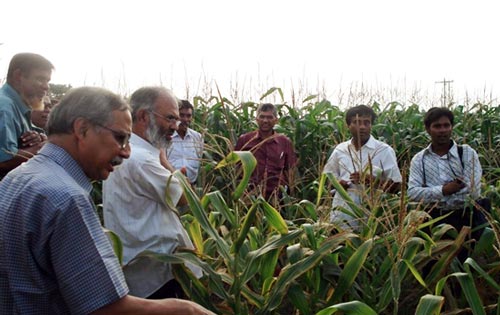 Though the project, which started in November 2008, initially focused on adaptive research in farmers’ fields, it is now starting to emphasize dissemination of improved CA practicies and SSNM technologies to farmers as well. This will be done through training and capacity building with researchers, farmers, extension workers, machinery manufacturers, and service providers.
Though the project, which started in November 2008, initially focused on adaptive research in farmers’ fields, it is now starting to emphasize dissemination of improved CA practicies and SSNM technologies to farmers as well. This will be done through training and capacity building with researchers, farmers, extension workers, machinery manufacturers, and service providers.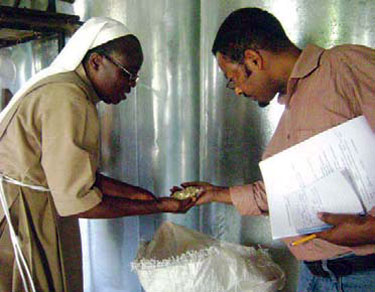 Would you store grain in a metal can? That was the question posed during a humorous skit presented at a stakeholders’ workshop in Homa Bay, Kenya. The can in question is the metal silo and the performance was part of an awareness exercise organized by the Catholic Diocese of Homa Bay. The diocese partners with CIMMYT in the Effective Grain Storage project, where CIMMYT previously facilitated the training of artisans. The project has since continued its work on improved grain storage and creating awareness about the metal silo.
Would you store grain in a metal can? That was the question posed during a humorous skit presented at a stakeholders’ workshop in Homa Bay, Kenya. The can in question is the metal silo and the performance was part of an awareness exercise organized by the Catholic Diocese of Homa Bay. The diocese partners with CIMMYT in the Effective Grain Storage project, where CIMMYT previously facilitated the training of artisans. The project has since continued its work on improved grain storage and creating awareness about the metal silo.